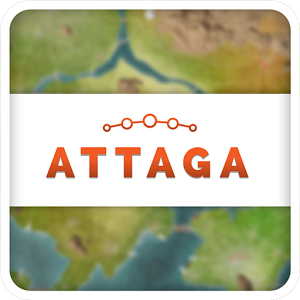Railway strategy game
Land of ATTAGA
Welcome to The Land of Anticipation, Timed Tactics And Gruelling Abstruseness. Attaga is a country with 40 cities and villages with a strong need for a fast, reliable and high comfort railway network. The inhabitants happiness depends on you!
This railway strategy game will guide you through the process of decision-making while building your own rail network, operating it and keeping it maintained.

New MOOC on Railway Engineering
The Land of ATTAGA is developed as part of a brand new Massive Open Online Course on 'the complexity behind your daily train ride' and is best experienced in combination with this free MOOC. Like the game this course is freely accessible anywhere in the world.
This MOOC will give you the opportunity to become familiar with the technology and complexity behind railway designs, people flow, operations, delays and maintenance. And most importantly how all these aspects are related to each other. This six-week course (estimated effort of 4-5 hours per week) runs twice a year (starting in March and October). Each week is based on a main topic (cluster), which is presented and discussed in an accessible, attractive and exciting way.
Week 1: Track systems, vehicle types and track/train interaction;
Week 2: User experience, railway stations, people flow and impact on environment;
Week 3: Timetabling, real time traffic management and track capacity;
Week 4: Disturbances and the technology and complexity behind them;
Week 5: Monitoring and maintenance techniques and decision making;
Week 6: Current developments, future designs and special systems.
Throughout the course we compare the Dutch situation to rail networks in other countries. We analyze differences and similarities, and through our interactive World Map, learners can share and compare information and imagery with other participants. Within the course we make use of interactive images, animations and mini-lectures (knowledge clips) to explain complexity in a visual and understandable way.
The first run of the MOOC has been a great success with learners registering from over 130 countries. This international component creates a unique opportunity where people interested in this field can meet, share and interact. Since rail networks can be found anywhere in the world, this is a great way to see how challenges are approached across the globe and what we can learn from these insights and perspectives.
Get the full experience and enroll for this free course though the edX-platform!
Game manual
Cities have to be connected in an ever-changing setting, and you will need to deal with wear, capacity, developments and disturbances. The performance of your railway system over time is based on choices and priorities made and set by you as the player, within an increasingly complex situation.
Communities come in five sizes; 200, 500, 1000, 2500 and 5000 people and can grow over time. All communities above 500 inhabitants need to be connected to the railway network, whereas villages of 200 won't affect your score in a negative way (but watch out for population growth over time!).
Goals
The main goal of the game is to have a high percentage of customer happiness over time. This is based on the average customer satisfaction measured continuously while playing. The current value is visible at the bottom of the screen, next to the overall percentage, and is influenced by four main factors:
- Customers served: Does your network meets the demand of the different cities?
- Comfort: Can people travel directly or do they have to switch lines?
- Travel time: How close can you get to the fastest possible connection?
- Reliability: How often do lines break down and how fast are they fixed?
As a user, you can create new connections between cities using local and interstate trains, create high-speed connections between your larger cities and connect the rail network to foreign countries. In hilly areas only mountain trains can be used.
The main menu and controls
As a user, you can create new connections between cities using local and interstate trains, create high-speed connections between your larger cities and connect the rail network to foreign countries. In hilly areas only mountain trains can be used. The main menu consists of six main tabs, with two important actions within 'cities' and 'tracks'.
Missions: Find your next mission and see what you have accomplished so far. Financial rewards give you possibilities to develop your network faster.
Events: Get updates on city growth, track status and local weather circumstances. Where did a track break down and which area needs your attention?
Cities: Oversee all cities and villages on the map with local properties to make correct decisions and set priorities and check if there is a passing station.
>> Connect: Use this button to create a new connection or extend an exiting line from a selected city, choosing type of track, train frequency and number of switches.
Tracks: Get a list of all your tracks and check their fail rate. Use monitoring trains to get more detailed information on the status of your tracks.
>> Maintain: Use this button to direct your crews to maintain or repair tracks. Be aware that this costs time and you only have three crews at your disposal.
Lines: Find all created lines with start and end station. Update the frequency to meet the changing demand, as more people start using your network.
Control: Gain knowledge on your track status by buying and updating a monitoring train and upgrade your control system for higher train frequency.
You can see the menu on the right of game, as shown in this screenshot:

Good to know
- Money is generated by serving customers (tickets) and by accomplishing missions
- Red dots in the menu indicate either the occurrence of a new event or a successful mission
- Building, maintaining and repairing tracks costs time, resulting in temporary unavailable crews
- Small/large bridges/tunnels, national parks, length, type of train/track and frequency increase costs
- Fail rate is an indication of wear and tear; tracks can always break down due to external factors
- Repairing a track costs three times as much compared to maintaining it in time
- Interstate trains can pass local trains at smaller stations using the same line
Colouring of the tracks
White: In service
Red: Closed
Orange: In service, but too little capacity
Grey: Being maintained or repaired
Green: Being built
Blue: Selected line to extend
Current development
- Saving progress: Where there is no safe-button implemented in the game at this time, it is possible to switch windows within your browser which will stop the calculations and pauze the game.
- 'Calculating...': If you see this in the left upper corner, it means it calculates all tracks, lines and routes. This might cause a hitch while playing.
- Missions: In some cases the order of completing missions affects the rewarding system, which might lead to an incomplete mission where all requirements are met.
Our team is working on improving the game and adding new features, but in the mean time we apologise for any inconvenience you might experience. We hope you will understand that this is the very first we are working with this new railway game and therefor do come across some teething problems.
Support us in improving the experience
Both our MOOC as well as the game are based on a non-commercial approach and freely accessible for everyone around the world as an interactive and fun educational tool. We appreciate any support to further develop the game and integrate more features, bringing the player's experience to a higher level.
You can contribute to the improvement of this game and realisation of other educational railway games at TU Delft, by making a donation to our development fund. We much appreciate any gestures that help us create more exiting online learning tools to share with the world!
More information can be acquired via rail@tudelft.nl.
